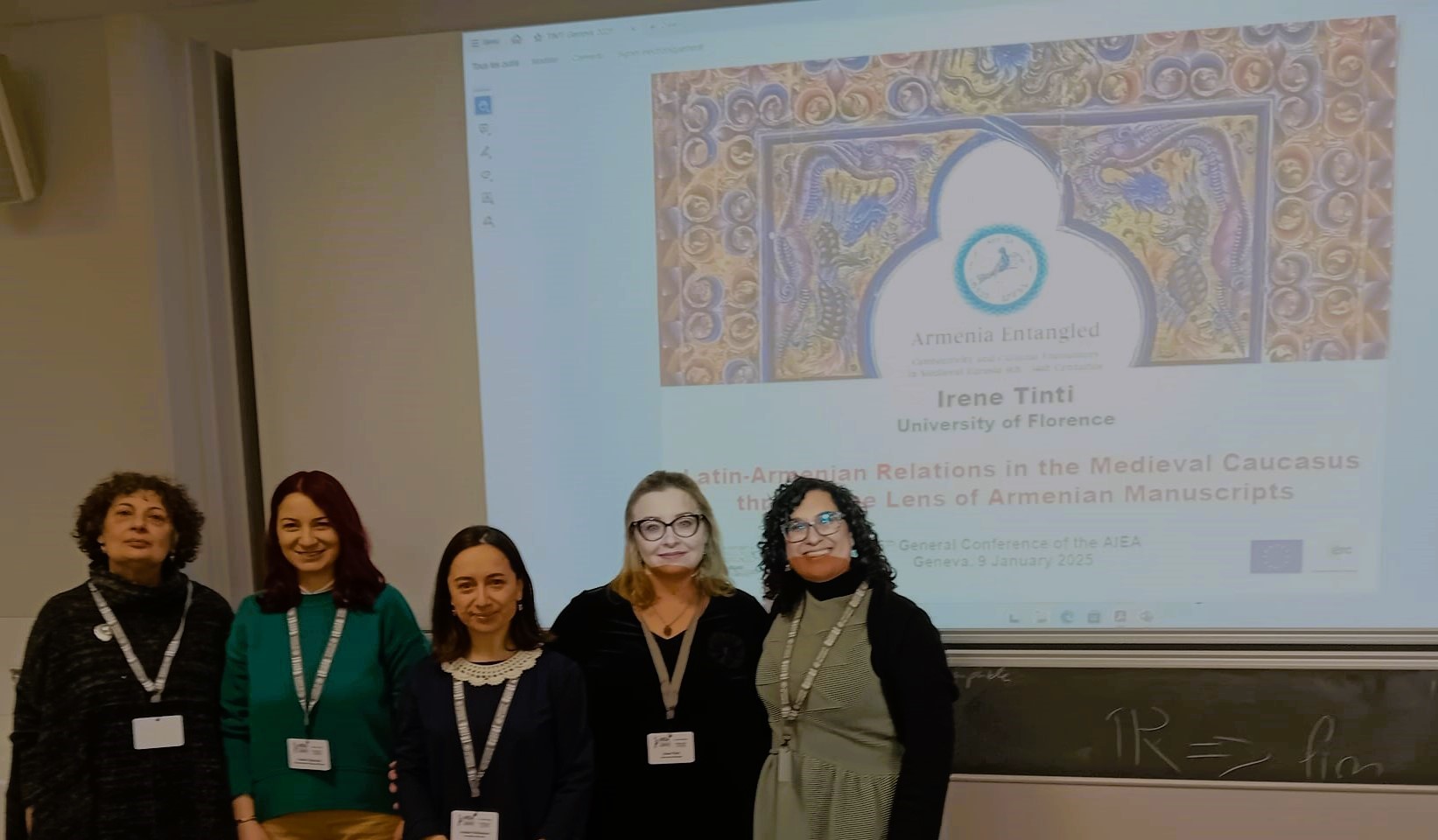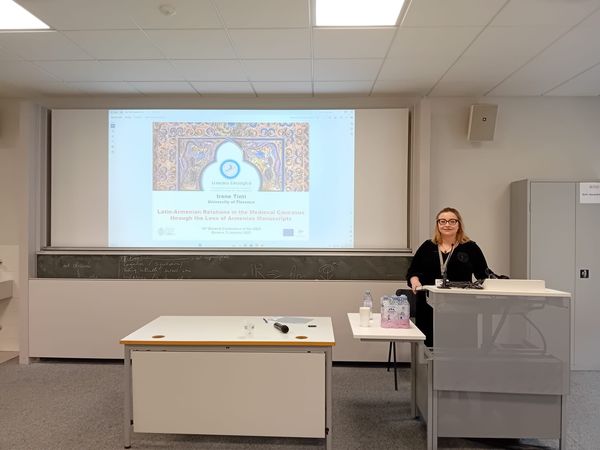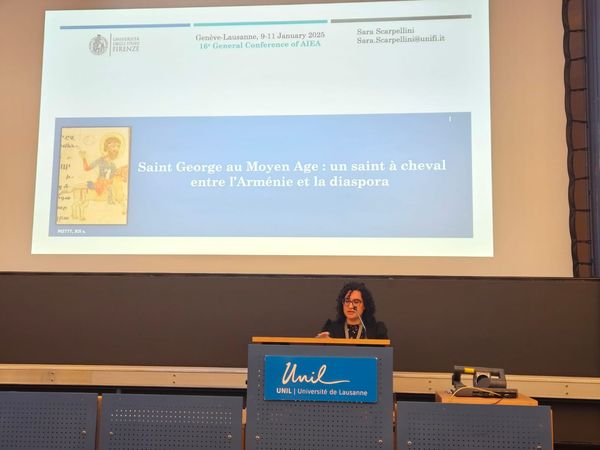ArmEn and HAI Mobility Team Members at the 16th General Conference of the Association Internationale des Études arméniennes
Three ArmEn (Grigoryan, Melkonyan, Tinti) and two HAI Mobility (Scarpellini, Vardanyan) team members took part in the 16th General Conference of the Association Internationale des Études arméniennes (AIEA), held at the Universities of Geneva and Lausanne (Switzerland) on 9‒11 January 2025. Irene Tinti was also a member of the scientific committee of the conference, in her capacity as Treasurer and member of the steering committee of the association.
The full programme and all abstracts can be found on the AIEA’s website.
The conference involved around 70 participants from Europe, Armenia, and the United States, and was organised in plenary and parallel sessions.

Irene Tinti and Armine Melkonyan presented their papers during a session devoted to Latin-Armenian relations and religious disputations in the Middle Ages, held at the University of Geneva on 9 January and chaired by Gohar Grigoryan. Tinti also chaired the session devoted to Linguistics (Geneva, 9 January).

Tinti’s presentation, titled Latin-Armenian Relations in the Medieval Caucasus through the Lens of Armenian Manuscripts, addressed the manuscript tradition of the Armenian version of Peter of Aragon’s Book of Virtues (1339) and what the text’s afterlife can reveal about confessional and cultural entanglements in the Medieval Caucasus. This compilation on moral theology based on Western sources was originally composed in Latin and translated into Armenian in a Catholic milieu at the monastery of Kʻṙnay (Naxiǰewan). However, the book soon played a significant role in intellectual and doctrinal debates and controversies: copies were produced in both Catholic and Apostolic monasteries, both in the 1300s and in the following centuries, with individual witnesses often including idiosyncratic variations. Furthermore, some of these codices crossed confessional boundaries, being used, edited, adapted to a different audience, and annotated by members of both camps, and providing both the inspiration and, occasionally, the physical medium for interconfessional debates. In this context and in the absence of a reliable critical edition, the possible means of accessing Peter’s own version of the text (or something as close to it as possible) were also discussed.

Melkonyan’s paper, Newly Discovered Armenian Interreligious Disputation: Manuscript Tradition and Textual Transmission, presented the text of a debate between a monk named Makar, a Persian emir, an anonymous Jew, a Nestorian and a sorcerer, unearthed in an Armenian Homiliary dating back to 1404. The presentation focused on some features of Armenian manuscripts containing this text: to date, 14 manuscripts, dating from the 12th to the 17th centuries, and a 12th-century flyleaf have been identified. Three of them contain a colophon by a possible translator of the Story: an Armenian king (or prince) of the Andzevats‘ik‘ province named Bardoghimēos, also called Apu Sahl, who records that he translated this work from Arabic, when he was captured by the “infidels” (Muslims). Melkonyan also discussed the passages and expressions that were most likely added by the Armenian translator or later editor(s), such as comparisons between Gregory the Illuminator and Muhammad, or mentions of the chief god Aramazd and the goddess of love and fertility Astghik from Armenian mythology. The study and edition of the text are being conducted in collaboration with ArmEn PI Zaroui Pogossian and team member Barbara Roggema.
Sara Scarpellini, Gohar Grigoryan, and Edda Vardanyan gave their presentations in three parallel sessions held at the University of Lausanne on 10 January.
Scarpellini’s paper, St George au Moyen Age : un saint à cheval entre l’Arménie et la diaspora, was part of the session devoted to Patristics and Hagiography. Her presentation focused on the figure of Saint George as a vector of entanglements between historical Armenia and the diasporic communities of the CAM area (Caucasus, Anatolia and Mesopotamia). Saint George was so popular that several texts and legends were created in the Middle Ages. Scarpellini presented an overview of the Armenian texts about Saint George as well as the recently discovered manuscripts containing those texts. By placing all these literary sources on a map, she attempted to show the spread of the cult of the Saint and identify his centres of worship in the CAM area. Furthermore, by analysing some of the most interesting case studies she highlighted the relationship(s) between the homeland and some Armenian communities outside historical Armenia.

Grigoryan gave her presentation, titled The Assizes of Antioch and the Visualisation of the King's Institution in Cilician Armenia, in a session devoted to the History of Cilicia. The paper demonstrated how the implementation of the Assizes of Antioch – a now-lost Frankish lawbook, only available through a mid-thirteenth-century Armenian translation – informed the decision-making principles of Cilician Armenian kings and their artistic portrayals. The case study presented at the conference focused on King Lewon IV (r. 1321-1341) and his contemporary image depicted on the frontispiece of the oldest extant copy of the Armenian Assizes of Antioch (Venice, Library of the Mekhitarist Congregation, MS 107). Commissioned by the king himself in 1331, this juridical codex bears precious testimony to how visual and aesthetic means were put into play by the royal apparatus in such a precarious situation, when the young king faced serious political and legal challenges.
Finally, Vardanyan’s paper, La version arménienne du Roman d’Alexandre et l’école monastique de Gladzor, was part of the session called Hellenizing School. Alexander Roman. It linked the Alexander Romance manuscript copied and illustrated in the early 14th century (Venice, Library of the Mekhitarist Congregation, MS 424) with the activities of the Gladzor monastic school. This connection was made in light of philological, literary, historical and ideological arguments, in addition to pictorial parallels. These are a series of literary additions to the main text of the Pseudo-Callisthenes, made by Xač'atur Keč'aṙec'i, which correspond to the pedagogical and ideological needs cultivated at Gladzor. The new version of the Romance reflects on the one hand the anti-uniate fight, and on the other a royal ideology as well as nostalgia for a lost kingdom. The connections between manuscript V424 and Gladzor's activities underline the interaction between culture, religion and politics at that time and in that region. Thus, Gladzor is considered to be the probable place of creation of this manuscript, and of the overall project to transform the Alexander Romance.
Last update
17.01.2025
